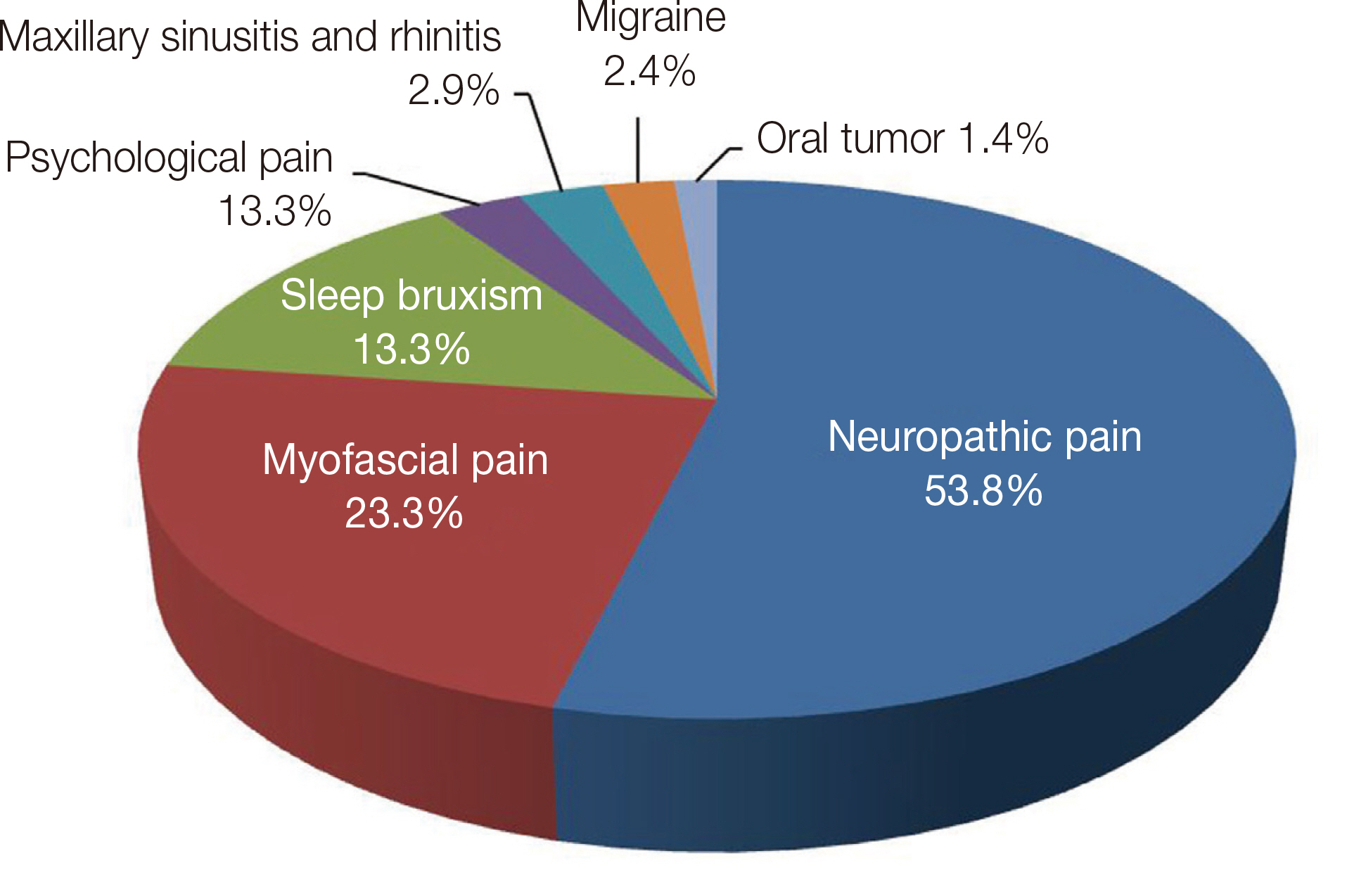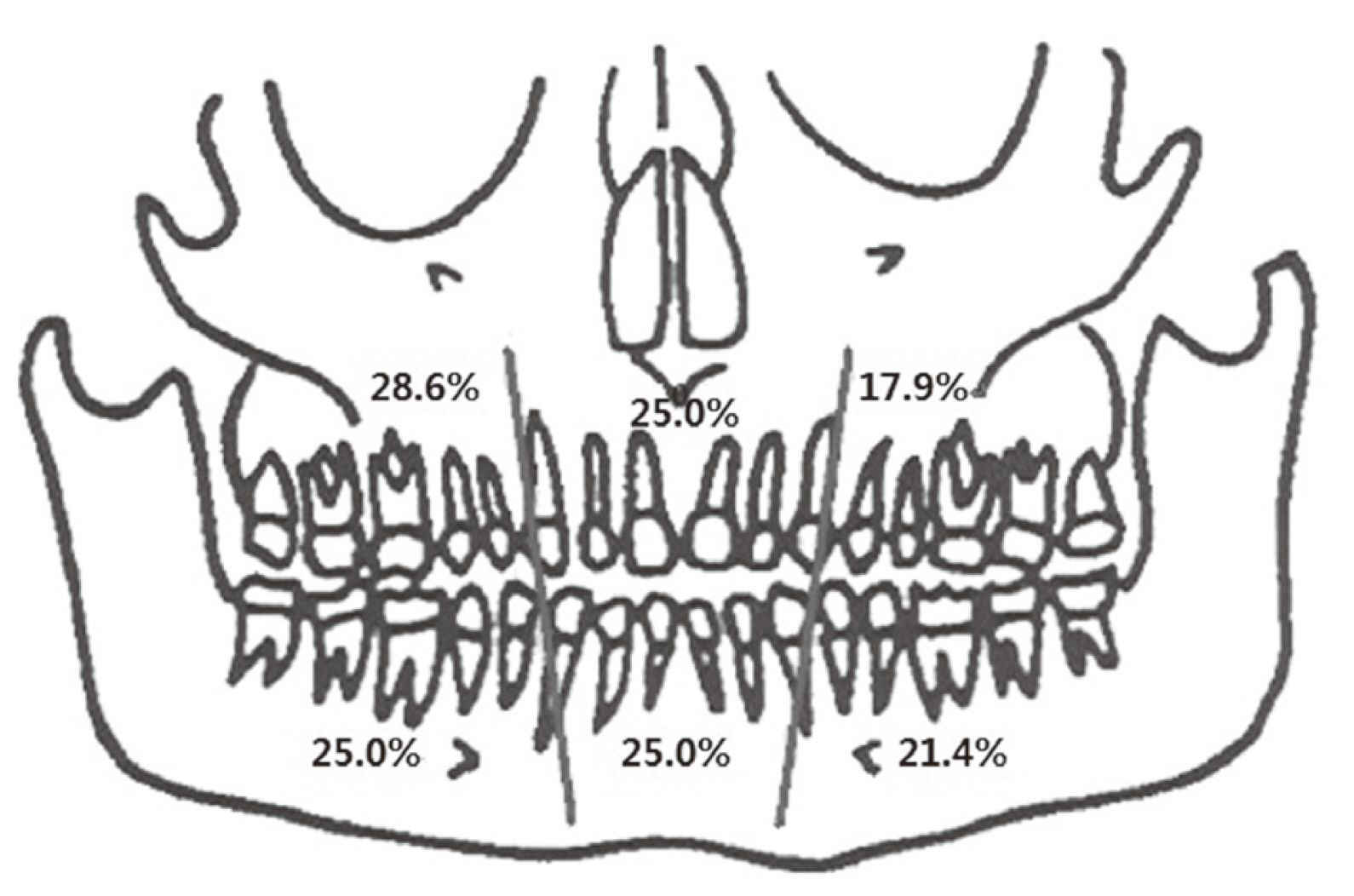J Dent Rehabil Appl Sci.
2021 Jun;37(2):81-87. 10.14368/jdras.2021.37.2.81.
Clinical characteristics of sleep bruxism patients with idiopathic facial pain
- Affiliations
-
- 1Department of Orofacial Pain and Oral Medicine, Yonsei University College of Dentistry, Seoul, Republic of Korea
- KMID: 2525981
- DOI: http://doi.org/10.14368/jdras.2021.37.2.81
Abstract
- Purpose
To profile various clinical characteristics of sleep bruxism (SB) patients with idiopathic facial pain (IFP) in the orofacial region.
Materials and Methods
We analyzed 28 SB patients among 210 patients with IFP complaints. The profiles were evaluated using patient charts including gender, age, pain duration, pain location, pain intensity and affected areas by pain.
Results
SB with IFP occurred more often in females (85.7%) than males (14.3%). The mean age at presentation was 48.9 years. The most common IFP sites of SB patients were the right maxilla (28.6%) and the right mandible (25.0%). The pain complaints occurred mostly in 2 teeth or areas (50.0%), followed by 1 area (28.6%) and then in ≥ 3 teeth or areas (21.4%). The mean pain intensity was 5.9 on a visual analogue scale from 0 to 10. The pain was spontaneous in 20 patients (71.4%), and the mean pain duration was 24.4 months.
Conclusion
Identification of clinical characteristics of SB patients with IFP could be useful in the diagnosis of various IFP patients and beneficial in decreasing unnecessary care to reduce IFP. Further studies with larger number of subjects and extended duration are required for more systemized diagnostic methods and development of future treatment guidelines.
Figure
Reference
-
References
1. de Leeuw R, Klasser GD. 2013. Orofacial pain: guidelines for assessment, diagnosis, and management. 5th ed. Quintessence;Chicago:2. Carra MC, Huynh N, Lavigne G. 2012; Sleep bruxism: a comprehensive overview for the dental clinician interested in sleep medicine. Dent Clin North Am. 56:387–413. DOI: 10.1016/j.cden.2012.01.003. PMID: 22480810.3. Camparis CM, Siqueira JT. 2006; Sleep bruxism: clinical aspects and characteristics in patients with and without chronic orofacial pain. Oral Surg Oral Med Oral Pathol Oral Radiol Endod. 101:188–93. DOI: 10.1016/j.tripleo.2005.01.014. PMID: 16448920.4. Ram S, Teruel A, Kumar SK, Clark G. 2009; Clinical characteristics and diagnosis of atypical odontalgia: implications for dentists. J Am Dent Assoc. 140:223–8. DOI: 10.14219/jada.archive.2009.0136. PMID: 19188419.5. Yatani H, Komiyama O, Matsuka Y, Wajima K, Muraoka W, Ikawa M, Sakamoto E, De Laat A, Heir GM. 2014; Systematic review and recommendations for nonodontogenic toothache. J Oral Rehabil. 41:843–52. DOI: 10.1111/joor.12208. PMID: 25040436.6. Mattscheck D, Law AS, Nixdorf DR. Hargreaves KM, Cohen S, Berman LH, editors. 2011. Diagnosis of non-odontogenic toothache. Cohen's Pathways of the Pulp. 10th ed. Mosby;St Louis: p. 49–70. DOI: 10.1016/B978-0-323-06489-7.00003-5.7. Rompré PH, Daigle-Landry D, Guitard F, Montplaisir JY, Lavigne GJ. 2007; Identification of a sleep bruxism subgroup with a higher risk of pain. J Dent Res. 86:837–42. DOI: 10.1177/154405910708600906. PMID: 17720851.8. Tomoyasu Y, Higuchi H, Mori M, Takaya K, Honda Y, Yamane A, Yabuki A, Hayashi T, Ishii-Maruyama M, Jinzenji A, Maeda S, Kohjitani A, Shimada M, Miyawaki T. 2014; Chronic orofacial pain in dental patients: retrospective investigation over 12 years. Acta Med Okayama. 68:269–75. DOI: 10.18926/AMO/52895. PMID: 25338483.9. Carra MC, Huynh N, Morton P, Rompré PH, Papadakis A, Remise C, Lavigne GJ. 2011; Prevalence and risk factors of sleep bruxism and wake-time tooth clenching in a 7- to 17-yr-old population. Eur J Oral Sci. 119:386–94. DOI: 10.1111/j.1600-0722.2011.00846.x. PMID: 21896056.10. Vendrame M, Kaleyias J, Valencia I, Legido A, Kothare SV. 2008; Polysomnographic findings in children with headaches. Pediatr Neurol. 39:6–11. DOI: 10.1016/j.pediatrneurol.2008.03.007. PMID: 18555166.11. Lobbezoo F, Lavigne GJ. 1997; Do bruxism and temporomandibular disorders have a cause-and-effect relationship? J Orofac Pain. 11:15–23. PMID: 10332307.12. Lobbezoo-Scholte AM, Lobbezoo F, Steenks MH, De Leeuw JR, Bosman F. 1995; Diagnostic subgroups of craniomandibular disorders. Part II: Symptom profiles. J Orofac Pain. 9:37–43. PMID: 7581203.13. List T, Leijon G, Helkimo M, Öster A, Svensson P. 2006; Effect of local anesthesia on atypical odontalgia-a randomized controlled trial. Pain. 122:306–14. DOI: 10.1016/j.pain.2006.02.005. PMID: 16564621.14. do Nascimento LL, Amorim CF, Giannasi LC, Oliveira CS, Nacif SR, de Moura Silva A, Nascimento DFF, Marchini L, de Oliveira LVF. 2008; Occlusal splint for sleep bruxism: an electromyographic associated to Helkimo Index evaluation. Sleep Breath. 12:275–80. DOI: 10.1007/s11325-007-0152-8. PMID: 17987334.15. van der Zaag J, Lobbezoo F, Wicks DJ, Visscher CM, Hamburger HL, Naeije M. 2005; Controlled assessment of the efficacy of occlusal stabilization splints on sleep bruxism. J Orofac Pain. 19:151–8. PMID: 15895838.16. Jokstad A. 2009; The NTI-tss device may be used successfully in the management of bruxism and TMD. Evid Based Dent. 10:23. DOI: 10.1038/sj.ebd.6400635. PMID: 19322228.17. Winocur E, Gavish A, Voikovitch M, Emodi-Perlman A, Eli I. 2003; Drugs and bruxism: a critical review. J Orofac Pain. 17:99–111. PMID: 12836498.18. Lavigne G, Manzini C, Huynh NT. Kryger MH, Roth T, Dement WC, editors. 2011. Sleep bruxism. Principles and practice of sleep medicine. 5th ed. Elsevier Saunders;St. Louis: p. 1129–39. DOI: 10.1016/B978-1-4160-6645-3.00099-2.19. Raigrodski AJ, Christensen LV, Mohamed SE, Gardiner DM. 2001; The effect of four-week administration of amitriptyline on sleep bruxism. A double-blind crossover clinical study. Cranio. 19:21–5. DOI: 10.1080/08869634.2001.11746147. PMID: 11842836.
- Full Text Links
- Actions
-
Cited
- CITED
-
- Close
- Share
- Similar articles
-
- Sleep and Dentistry
- Diagnosis and Management of Bruxism
- Efficacy of botulinum toxin in the management of temporomandibular myofascial pain and sleep bruxism
- Implant complications in bruxism patients
- Application of botulinum toxin in maxillofacial field: Part II. Wrinkle, intraoral ulcer, and cranio-maxillofacial pain




